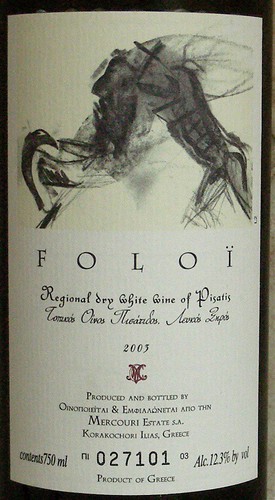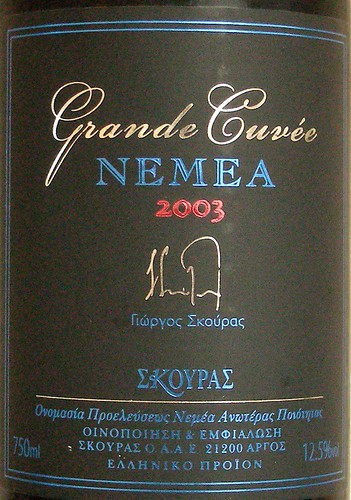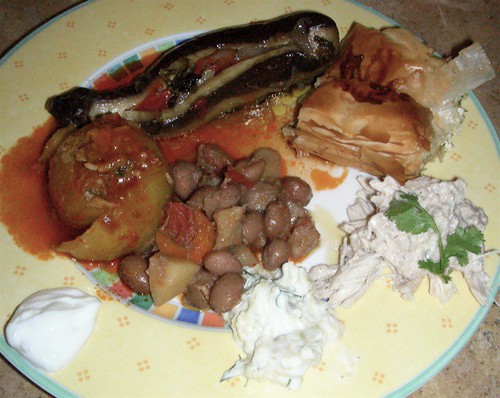The Peloponnese has a long tradition of winemaking. In the ancient times, Homer called it Ampeloessa, which means of vine leaves. Many indigenous grapes grow in the region, including the white varieties, Roditis, Sklava, Moschofilero and the red Agiorgítko. International varieties such as Chardonnay, Viognier, Cabernet Sauvignon, and Merlot are also cultivated and increasingly popular among winemakers that want to win entry into the foreign markets.
 Our first wine was the 2003 Mercouri Foloi Roditis, “a fine, dry wine made from the Roditis variety grown at altitude on the plateau of Foloi, Ilias, in West Peloponnese, Greece — an area famous in Greek mythology for its aromatic wines.”, as it is described in the back label.
Our first wine was the 2003 Mercouri Foloi Roditis, “a fine, dry wine made from the Roditis variety grown at altitude on the plateau of Foloi, Ilias, in West Peloponnese, Greece — an area famous in Greek mythology for its aromatic wines.”, as it is described in the back label.Roditis is a white variety that mainly grows in Central Greece and in the Peloponnese. The finest Roditis wines are produced from low-yielding, high elevation vineyards with a north-facing exposure. The wine had a light golden color and a nose of lime and grapefruit. The palate was crisp and well rounded with a refreshing finish of herbs and light spices. I really enjoyed the wine with the Imam Bayildi dish (The Imam Fainted), a dish of eggplants stuffed with onions, garlic, and tomatoes, simmered in olive oil.
 Our red wine was the 2003 Skouras Grande Cuvée from the Neméa appellation. Neméa is now considered by some to be Greece's most important appellation. It produces deeply colored and complex red wines exclusively from the Agiorgítko grape. The wine had a dark purple color and a peppery nose of blackberry and blackcurrant. The palate was medium-bodied with a well balanced acidity and notes of mint on the finish. The wine was a great accompaniment to Kabak Dolmasi, a tasty dish of zucchini stuffed with ground beef, rice, onion and spices, and served with a yogurt, dill, and garlic sauce.
Our red wine was the 2003 Skouras Grande Cuvée from the Neméa appellation. Neméa is now considered by some to be Greece's most important appellation. It produces deeply colored and complex red wines exclusively from the Agiorgítko grape. The wine had a dark purple color and a peppery nose of blackberry and blackcurrant. The palate was medium-bodied with a well balanced acidity and notes of mint on the finish. The wine was a great accompaniment to Kabak Dolmasi, a tasty dish of zucchini stuffed with ground beef, rice, onion and spices, and served with a yogurt, dill, and garlic sauce.
Technorati tags: wine food & drink
No comments:
Post a Comment